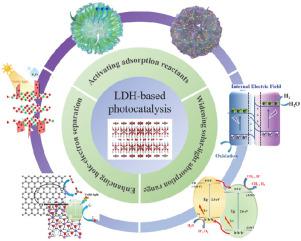Chinese Journal of Catalysis ( IF 16.5 ) Pub Date : 2021-08-30 , DOI: 10.1016/s1872-2067(21)63861-5 Kailin Wang 1 , Tianqi Wang 1 , Quazi Arif Islam 1 , Yan Wu 1

|
Splitting water or reducing CO2 via semiconductor photocatalysis to produce H2 or hydrocarbon fuels through the direct utilization of solar energy is a promising approach to mitigating the current fossil fuel energy crisis and environmental challenges. It enables not only the realization of clean, renewable, and high-heating-value solar fuels, but also the reduction of CO2 emissions. Layered double hydroxides (LDHs) are a type of two-dimensional anionic clay with a brucite-like structure, and are characterized by a unique, delaminable, multidimensional, layered structure; tunable intralayer metal cations; and exchangeable interlayer guest anions. Therefore, it has been widely investigated in the fields of CO2 reduction, photoelectrocatalytic water oxidation, and water photolysis to produce H2. However, the low carrier mobility and poor quantum efficiency of pure LDH limit its application. An increasing number of scholars are exploring methods to obtain LDH-based photocatalysts with high energy conversion efficiency, such as assembling photoactive components into LDH laminates, designing multidimensional structures, or coupling different types of semiconductors to construct heterojunctions. This review first summarizes the main characteristics of LDH, i.e., metal-cation tunability, intercalated guest-anion substitutability, thermal decomposability, memory effect, multidimensionality, and delaminability. Second, LDHs, LDH-based composites (metal sulfide-LDH composites, metal oxide-LDH composites, graphite phase carbon nitride-LDH composites), ternary LDH-based composites, and mixed-metal oxides for splitting water to produce H2 are reviewed. Third, graphite phase carbon nitride-LDH composites, MgAl-LDH composites, CuZn-LDH composites, and other semiconductor-LDH composites for CO2 reduction are introduced. Although the field of LDH-based photocatalysts has advanced considerably, the photocatalytic mechanism of LDHs has not been thoroughly elucidated; moreover, the photocatalytic active sites, the synergy between different components, and the interfacial reaction mechanism of LDH-based photocatalysts require further investigation. Therefore, LDH composite materials for photocatalysis could be developed through structural regulation and function-oriented design to investigate the effects of different components and interface reactions, the influence of photogenerated carriers, and the impact of material composition on the physical and chemical properties of the LDH-based photocatalyst.
中文翻译:

用于太阳能燃料生产的层状双氢氧化物光催化剂
通过半导体光催化分解水或还原 CO 2 以通过直接利用太阳能生产 H 2或碳氢化合物燃料是缓解当前化石燃料能源危机和环境挑战的一种很有前景的方法。它不仅可以实现清洁、可再生和高热值的太阳能燃料,还可以减少 CO 2排放。层状双氢氧化物(LDHs)是一种具有类水镁石结构的二维阴离子粘土,具有独特的、可分层的、多维的层状结构;可调层内金属阳离子;和可交换的层间客体阴离子。因此,它在CO 2领域得到了广泛的研究。还原、光电催化水氧化和水光解产生H 2。然而,纯LDH的载流子迁移率低和量子效率差限制了其应用。越来越多的学者正在探索获得具有高能量转换效率的LDH基光催化剂的方法,例如将光活性组分组装成LDH层压板,设计多维结构,或耦合不同类型的半导体以构建异质结。本综述首先总结了 LDH 的主要特征,即,金属阳离子可调性、插入客体阴离子可替代性、热分解性、记忆效应、多维性和分层性。第二,水滑石,基于LDH-复合材料(金属硫化物-LDH复合材料,金属氧化物-LDH复合材料,石墨相的碳氮化物的LDH复合材料),三元基于LDH-复合材料,和混合的金属氧化物用于分离水以生成H 2综述. 三、石墨相氮化碳-LDH复合材料、MgAl-LDH复合材料、CuZn-LDH复合材料,以及其他用于CO 2 的半导体-LDH复合材料减少介绍。尽管LDH基光催化剂领域取得了长足的进步,但LDHs的光催化机理尚未完全阐明;此外,基于LDH的光催化剂的光催化活性位点、不同组分之间的协同作用以及界面反应机理需要进一步研究。因此,可以通过结构调控和功能导向设计来开发用于光催化的LDH复合材料,以研究不同组分和界面反应的影响、光生载流子的影响以及材料组成对LDH理化性质的影响。 -基光催化剂。


























 京公网安备 11010802027423号
京公网安备 11010802027423号